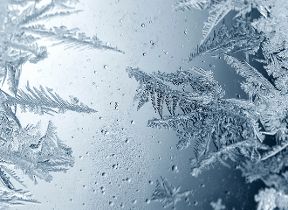Factors that influence UK winters
There are many factors that influence the weather during the winter months in the UK including the North Atlantic Oscillation.
North Atlantic Oscillation
The North Atlantic Oscillation (NAO) is the primary pattern of atmospheric circulation variability (the year-to-year change in the direction of the winds) over the North Atlantic region. In its positive phase, lower than normal sea-level pressure occurs near Iceland and higher than normal pressure over the Azores.
This enhanced gradient in pressure strengthens the westerly winds from the Atlantic bringing milder maritime air to the UK but also increased rainfall and more wind storms.
Conversely, in a negative NAO phase, the pressure is higher than usual over Iceland and lower than usual over the Azores, weakening the pressure gradient and reducing the strength of the westerly winds.
For the UK this means that more of our weather will come from the north or east which in winter means colder, drier and potentially snowy conditions. The NAO can be affected by many external factors, a few of which are described below:
Polar Vortex
The polar vortex is a circulation of winds high up in the stratosphere, up to 30 miles (50 km) above the Earth. It is present in winter, and it is not a new phenomenon, scientists have known about it for many years.
The winds regularly exceed 250 km per hour– the strength of the winds in the strongest hurricanes (known as Category 5).
During winter, the polar vortex can strengthen and weaken. These changes exert an influence lower down in the atmosphere and ultimately on our weather.
Changes in the polar vortex can mean a change in NAO and as a result the weather in the UK. A prolonged spell with a weakened polar vortex typically favours negative NAO and colder weather.
Arctic sea ice
The full extent of the influence of Arctic sea ice on UK weather is still being researched. However, it is known that sea ice cover can have a direct impact on atmospheric circulation patterns. The ice reflects sunlight back into the atmosphere, thereby helping maintain lower surface temperatures in the Arctic.
Over the last 35 years, Arctic sea ice extent has declined in response to climate change at an average rate of around 4 % per decade over the year as a whole, or by more than 10 % per decade looking at the summer alone.
One of the main drivers of our weather is the temperature difference between the equator and the North Pole, which is in balance with the prevailing westerly winds. Cold European winters occur when the NAO is negative and the usual westerly winds weaken or even reverse.
A reduction in the temperature difference between the equator and the North Pole due to declining sea ice could potentially reduce the strength of the westerly winds, leading to a greater occurrence of negative NAO and an increase the risk of cold winters.
However, warming could also cause air to rise over the Arctic. This would lead to lower surface pressure in that region, which would promote increased mid-latitude westerly winds and a positive NAO. This would correspond to a reduced risk of cold winters.
The relative importance of these two competing effects is uncertain and hence is an area of active research.
Tropical rainfall and our winter weather
Tropical rainfall is closely linked to the underlying ocean temperature. These temperatures change over weeks and months, much more slowly than our day-to-day weather. As a result, they can have big swings from one year to the next, due to events such as an El Niño, while remaining relatively constant within an individual winter.
Warm air rising in the tropics cools at height, causing water to condense into raindrops, which releases further heat into the atmosphere. It then floods outwards from the top of tropical weather systems to return to the surface at the edge of the tropics.
This high-level outflow of air can buckle the sub-tropical jet stream. The distortion can influence airflow to the north of the jet stream, spreading into the temperate mid-latitudes and creating weather patterns such as positive and negative NAO phases.
Some of the high and low pressure areas created in this way can persist for months and have a dramatic effect on the winter weather in the UK.





